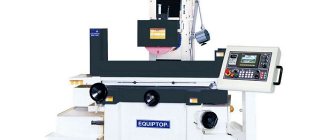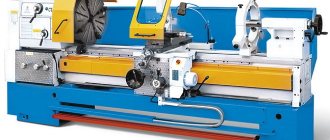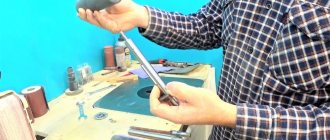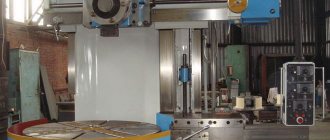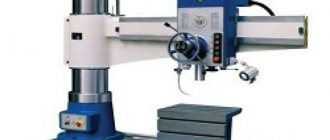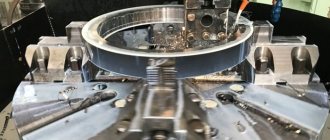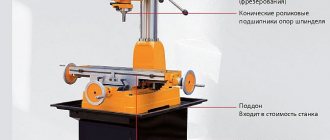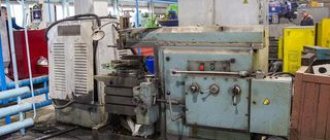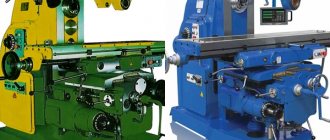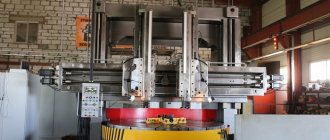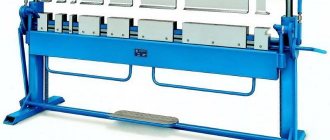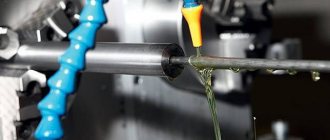A grinding machine is a device used to process workpieces made of various materials with an abrasive tool and can provide surface roughness from 0.02 to 1.25 microns. Grinding machines, which can have different designs, allow you to effectively solve problems associated with processing the surfaces of parts made of different materials.
One of the many types of grinding machines
Application of grinding machines
Using a grinding machine, you can carry out a number of technological operations:
- grinding of internal and external surfaces of parts having different shapes and purposes;
- sharpening of tools for various purposes;
- peeling, grinding, as well as cutting of metal castings and products with complex profiles;
- processing of gear parts and threaded parts;
- formation of keyed and spiral-type grooves on steel bars.
A grinding machine is practically indispensable when working with parts made of ceramic and magnetic materials that are difficult to process and highly fragile. In addition, grinding machines are capable of performing technological operations of grinding and roughening at high speed modes, which makes such equipment efficient and productive. On these machines, it is possible to remove a large amount of metal from the surface of the workpiece in a short period of time during processing.
The video below shows the operation of a CNC cylindrical grinding machine:
All grinding machines operate on the same principle: metal processing is carried out by simultaneous rotation of the abrasive wheel and movement or rotation of the workpiece. The working surface is the periphery or end of the abrasive wheel, and the workpiece moves relative to it along a straight or arc path. Any grinding machine contains in its design several kinematic chains that provide:
- movement of the work table in the longitudinal and transverse directions, which is possible thanks to a hydraulic drive;
- rotation of the working tool - the grinding wheel, carried out due to the individual drive of the working tool;
- feeding the workpiece or tool in the transverse direction due to a hydraulic or electromechanical drive;
- wheel dressing, which can be done manually using an electromechanical or hydraulic system;
- rotation of the workpiece or work table;
- supply of the working tool to depth, which can be performed using a hydraulic or mechanical drive.
Description and properties of the polishing process
GOST 9.301-86 regulates the requirements for the quality of processing of metal products as a result of polishing work. There are no special instructions regarding the gloss of surfaces after grinding, however, after polishing various defects, grooves, scratches, burrs, corrosion, etc. should be excluded.
In a word, polishing activities are designed to give the product an attractive appearance and consumer qualities.
In production there is such a thing as “polishing class”. The level of surface roughness of a particular part is determined using special equipment (microscopes and profilographs) down to 1 micrometer (μm, 1 mm = 1000 μm). If metal grinding is carried out at home, then the depth of the unevenness is determined by eye.
There are 14 roughness classes, which are indicated in special drawings in accordance with GOST 2789-59.
Polishing classes and requirements for them are presented in the table below.
| Surface description | Roughness size (up to microns) | Polishing class | Mechanical processing method |
| Traces of processing are very noticeable | 320 | 1 | Planing, sharpening and milling |
| 160 | 2 | ||
| 80 | 3 | ||
| Traces of processing are very faintly visible | 40 | 4 | Soft abrasive, semi-finishing |
| 20 | 5 | ||
| 10 | 6 | ||
| Traces of processing are not visible at all | 6,3 | 7 | Fine flow, grinding |
| 3,2 | 8 | ||
| 1,3 | 9 | ||
| The surface of the metal product is perfectly smooth and has a characteristic mirror shine | 0,8 | 10 | Final polishing, soft polishing |
| 0,4 | 11 | ||
| 0,2 | 12 | ||
| 0,1 | 13 | ||
| 0,05 | 14 |
Classification of grinding equipment
Depending on the application, grinding machines are divided into a number of types.
Cylindrical grinders
This equipment is designed for grinding cylindrical (Ø 25–600 mm) and conical workpieces. Such machines have in their design a spindle that rotates in a horizontal plane, which can move on a special slide. The part to be machined may be clamped in the chuck or between the centers of the tailstock and headstock.
Cylindrical grinding machine
Universal cylindrical grinding
machines Such machines are used for grinding the outer and end surfaces of cylindrical workpieces (Ø 25–300 mm), as well as conical parts. To perform processing, workpieces can be fixed in centers or in a chuck.
Universal cylindrical grinding machine
Plunge cylindrical grinding
Grinding machines of this type are used for processing cylindrical (Ø 150–400 mm), conical and profile workpieces, which are fixed in the centers of the equipment. Processing is carried out due to the transverse movement (cutting) of the abrasive wheel.
Plunge cylindrical grinding machine
Centerless cylindrical grinding
Processing on such equipment can be performed according to two schemes: by pass (cylindrical surfaces (Ø 25–300 mm)) and by plunge method (cylindrical, conical and profile surfaces). A distinctive feature of grinding machines of this type is that their design does not provide centers for fixing workpieces.
Centerless cylindrical grinding machine
Roll grinding
This includes machines for grinding rolling rolls of cylindrical, conical and profile configurations. Fixation of workpieces on machines of this type is carried out using equipment centers.
Roll grinding machine
For grinding crankshaft journals
On such machines, working using the plunge method, simultaneous or sequential grinding of the crankpins of crankshafts is performed.
Machine for grinding crankshaft journals
Internal
These devices allow you to process cylindrical and conical holes in a wide range of sizes (with a diameter of 1–10 cm on a benchtop grinding machine and up to 100 cm on a production one).
Internal grinding machine
Surface grinding
Processing on such equipment is performed with the end or periphery of the abrasive wheel. Grinding machines of this type can be equipped with additional devices, which makes it possible to process metal workpieces of complex configurations. Depending on the location of the spindle, surface grinding machines can be horizontal or vertical. The design of such devices may also include one or two columns.
Surface grinding machine
Double-sided surface grinding
This equipment can simultaneously process two flat surfaces, which significantly increases its productivity. Such grinding machines, in which the workpieces are fixed on a special feeding device, can be of a vertical or horizontal type.
Double-sided surface grinder
For grinding guides
The maximum length of guides that can be processed using these grinding machines is 1000-5000 mm. Guides of these types are equipped with beds, work tables, slides and other equipment components for various purposes.
Universal sharpening
Such grinding machines are used for sharpening various tools with a maximum diameter of 100–300 mm (taps, reamers, countersinks, cutters, etc.). The technical capabilities of equipment of this type make it possible to equip it with additional devices for processing cylindrical workpieces, as well as for internal and end grinding.
Universal sharpening machine
Roughing and grinding
This grinding equipment is used for roughening and cleaning the surface of workpieces by grinding. These machines use abrasive wheels with a diameter of 100–800 mm.
Roughing and grinding machine
Flat-lapping
This grinding equipment is used to perform grinding of workpieces with flat and cylindrical surfaces. The diameter of the abrasive discs that are installed on such machines is 200–800 mm.
Flat lapping machine
Round lapping
On this equipment, lapping of calibration and measuring tools made of metal is performed. The maximum diameter of gauges and tools that can be processed on machines of this type is 50–200 mm.
Grinding and lapping
With the help of such equipment, holes are ground in, the maximum diameter of which is 100–300 mm.
Grinding and lapping machine
Grinding and finishing
These are machines designed to perform finishing (lapping) operations. Such devices process various metal products: crankshafts with a maximum diameter of 100–200 mm, equipment spindles, pistons, etc.
Polishing
Such machines are used to polish metal parts. This universal equipment can be used to polish flat, cylindrical, conical, internal surfaces, as well as workpieces of complex configurations. An endless belt with a width of 100–200 mm or a soft polishing wheel with a diameter of 100–200 mm can be used as a working tool on these machines.
Grinding and polishing machine
Honing
There are also honing machines that are used to perform fine grinding (0.04–0.08 mm per diameter).
Honing machine
Specifications
The polishing and grinding machine has the following technical characteristics:
- the power of the drive motor in private workshops is up to 200 W; in production, readings of up to 1 kW are used;
- a set of abrasive tools with grains from coarse to fine, as well as felt circles;
- rotation speed from 15 revolutions per minute;
- The size range of circles starts from a diameter of 250 mm, with a thickness of up to 50 mm.
Powerful machine
Making a simple grinding machine with your own hands
Considering the fact that serial grinding equipment is not cheap, it makes sense to think about making such a machine yourself. Even the simplest homemade machine, which is not at all difficult to make, will allow you to grind workpieces of various configurations with high efficiency and quality.
The supporting element of a homemade machine for performing grinding work is a frame on which two drums and an electric motor are mounted. To make the frame, you can use a thick steel sheet, from which a platform of the required size is cut out.
With the engine, everything is much simpler: it can be removed from an old washing machine that has already served its useful life. The drums can be made in sets; for this it is convenient to use a chipboard, from which discs of the required diameter are cut.
A simple homemade machine made from improvised means
Drive shaft mounting
Driven drum
Engine mount
As an example, we will analyze the sequence of actions for the manufacture of a homemade grinding machine, the bed of which has dimensions of 50x18 cm. First of all, the bed itself is cut out of a steel sheet, as well as the work table on which the electric motor will be mounted. The dimensions of such a table will be approximately 18x16 cm.
It is important that the ends of the bed and work table, which will be connected, be cut as evenly as possible. The thick sheet of metal from which you will make the frame and work table is difficult to cut by hand, so it is better to perform this procedure on a milling machine. It is necessary to drill three holes in the frame and work table and securely connect them with bolts. Only after this is the motor installed and securely connected to the surface of the work table so that the base of the motor fits snugly to the surface of the platform.
Another homemade machine, assembled “on the knee”
When choosing an electric motor for your homemade grinding equipment, it is important to pay attention to the power: it should be at least 2.5 kW, and the rotation speed should be about 1500 rpm. If you use a drive with more modest characteristics, the machine will have low efficiency. You can avoid the need to use a gearbox if you correctly select the diameters of the drive and tension drums.
The diameters of the drums should be selected depending on the speed at which the abrasive belt will move. So, if the belt speed should be approximately 20 m/sec, then it is necessary to make drums with a diameter of 20 cm. To install the tension drum, a fixed axis is used, and the drive one is fixed directly on the electric motor shaft. To make rotation of the tension drum easier, a bearing assembly is used. It is best to make the platform on which the tension drum is installed with some bevel; this will ensure smooth contact of the abrasive belt with the workpiece being processed.
The homemade option is a little more complicated
It won’t be particularly difficult to make drums for a homemade grinding machine. To do this, you need to cut square blanks measuring 20 by 20 cm from chipboard, and drill a hole in the center of each of them. These blanks are then assembled into a 24 cm thick package, which is machined to form a cylindrical drum with a diameter of 20 cm.
To prevent the abrasive belt from slipping on the drums, you can stretch wide rubber rings onto their surface, which are usually cut from the inner tube of a bicycle or moped. The width of the abrasive tape, which you can make yourself, should be about 20 cm.
Areas of use
The grinder is good and useful everywhere, including in the household - from competently sharpening a high-quality knife or tailor's scissors to grinding a complex part made of metal or other “difficult” material.
In other words, the tool is needed and will be useful on the farm. Moreover, it is quite possible to make it with your own hands. To do this, it is not at all necessary to have special equipment and solid professional experience.
Of course, you will have to tinker, but you will do exactly what you need and, most importantly, you will save a serious amount of money, up to several thousand American dollars.
Why are sizes important?
Curved surfaces can have a variety of, sometimes very intricate, shapes. If you want to get a perfectly smooth result, the sanding device must be of the appropriate size and be convenient to use, as well as be able to easily change the abrasive. For example, to bend a tabletop, it is best to use a sanding drum of such a height that it completely covers the work surface.
Alexander was faced with the task of straightening the curve of a kitchen countertop made of natural wood. For this task, a drum with a height of at least 10 cm was needed
It must be said that the diameter of the drum is also important. A tool that is too narrow will cause you a lot of trouble, and a tool that is too wide will be difficult to control. There is no point in making any mathematical calculations to calculate the diameter of the drum; such a problem can be solved, as they say, by eye.
